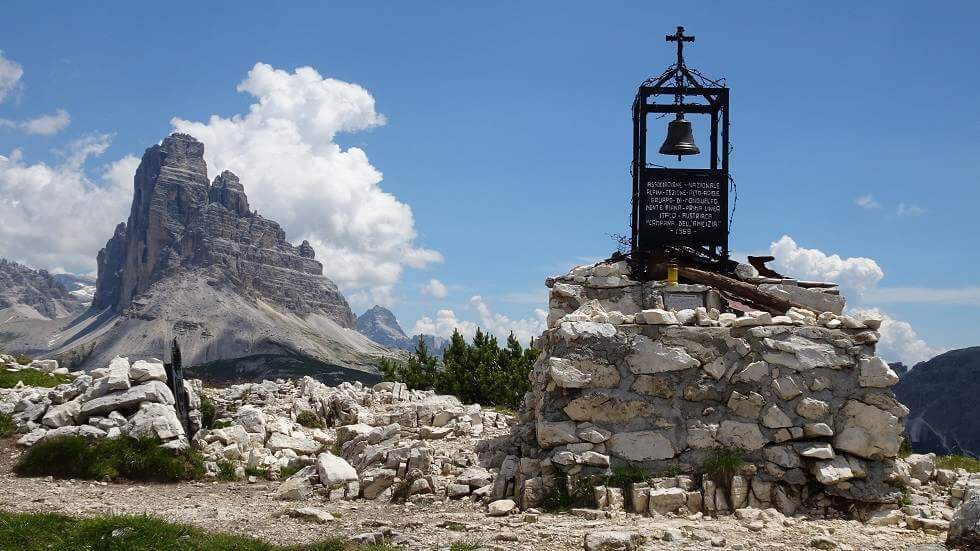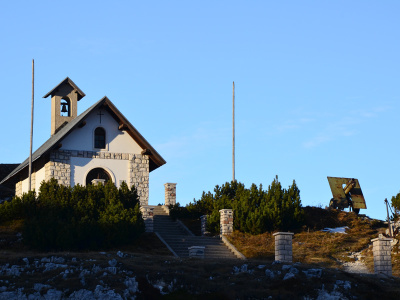
Il Monte Piana, o "Monte Piano" come viene chiamata la sua cima nord-est, costituisce una delle più attraenti mete delle Dolomiti grazie alla sua particolare conformazione ed alla sua posizione che offrono uno spettacolare panorama a 360 gradi verso le più belle montagne di Auronzo di Cadore e di Cortina d'Ampezzo - Tre Cime di Lavaredo, Paterno, Cadini di Misurina, Sorapiss, Cristallo, Croda Rossa ecc. - e verso il Lago di Misurina ai suoi piedi.
Il monte Piana fu teatro durante la prima guerra mondiale di uno scontro durato oltre due anni tra il Regio Esercito e l'esercito austro-ungarico, ed oggi è un vero e proprio "museo all'aperto" dove è possibile visitare il campo di battaglia situato in tutta la sua sommità. Tra il 1977 e il 1981, su iniziativa del Colonnello austriaco Walther Schaumann, venne istituito il "Museo Storico all'aperto di Monte Piana" visitabile da tutti, gratuitamente. I lavori per la risistemazione della trincee furono effettuati dal gruppo "Amici delle Dolomiti" (Dolomitenfreunde) con la ricostruzione dei camminamenti, delle trincee, delle gallerie e delle scalinate dell'epoca. Ogni anno dal 1983 il lavoro di ripristino delle trincee viene effettuato durante i primi quindici giorni di agosto, ad opera della "Fondazione Monte Piana" e degli "Amici delle Dolomiti" (che per l'occasione hanno costituito il "Gruppo Volontari Amici del Piana").
Nel 1988, in occasione del 70º anniversario della fine della Grande Guerra, sulla vecchia linea del fronte, lungo la forcella dei Castrati, è stata posizionata la "campana dell'amicizia e della concordia". La sua costruzione si deve all'alpino e successivamente poeta, Sergio Paolo Sciullo della Rocca. Nel giorno della sua inaugurazione la campana fu benedetta da don Michele D'Auria, che fu cappellano militare degli Arditi durante la campagna di Russia.
La campana fu realizzata in memoria delle vittime, ma soprattutto come monito per le nuove generazioni. Vicino all'opera, si trova una targa commemorativa, che ricorda la visita del re Vittorio Emanuele III su questo fronte della guerra.
La sommità del Monte Piana è raggiungibile tramite la strada comunale parzialmenete asfaltata chiusa al traffico, anche per le biciclette, dall'anno 1998. Partendo dal Lago di Misurina, situato nel Comune di Auronzo di Cadore (Belluno) a soli 12 km da Cortina d'Ampezzo, ripercorre il tortuoso e suggestivo itinerario della vecchia strada militare della Prima Guerra Mondiale che, nel tratto superiore, fu arditamente scavata nella roccia. Data la lunghezza della strada di 6 km ed il notevole dislivello di 565 metri, è stato predisposto un servizio jeep-navetta ( e in inverno è possibile utilizzare anche le motoslitte per poi ridiscendere con lo slittino ) che permette di percorrere in circa una dozzina di minuti i 5 km fino al Rifugio Angelo Bosi situato inferiormente alla cima a 2205 m., dove si trova anche la Cappella degli Eroi dedicata ai Caduti del Monte Piana.
Sul monte che vide tanto sacrificio di sangue ed eroismi di soldati, si volle erigere una chiesetta dedicata alla "Maria Santissima della Fiducia" e progettata dall'ing. Floriano Dall'Armi di Treviso. La pala in pietra è opera di Talete Costi, rappresenta la Madonna tra due soldati, uno ferito a morte, l'altro in armi e in atto di pregare. Venne costruita nel 1964-65 e consacrata nel 1966.
La cache si trova nelle vicinanze della chiesetta ed è di dimensioni micro. Portatevi una penna e ... buona caccia!


Monte Piana is one of the most beautiful site to visit in the Dolomites, with its special shape and position that offer a spectacular 360 degrees view towards the most famous mountains around Auronzo di Cadore and Cortina d'Ampezzo - Tre Cime di Lavaredo, Paterno, Cadini di Misurina, Sorapiss, Cristallo, Croda Rossa ecc. - and over the Lake of Misurina at its feet.
During the First World War, Monte Piana was the scene of a battle that lasted over two years between the Royal Army and the Austro-Hungarian army, and today it is a real "open-air museum" where it is possible to visit the battlefield. located throughout its summit. Between 1977 and 1981, on the initiative of the Austrian Colonel Walther Schaumann, the "Open-air Historical Museum of Monte Piana" was established, open to everyone, free of charge. The works for the rearrangement of the trenches were carried out by the group "Friends of the Dolomites" (Dolomitenfreunde) with the reconstruction of the walkways, trenches, tunnels and stairways of the time. Every year since 1983, the restoration work of the trenches has been carried out during the first fifteen days of August, by the "Monte Piana Foundation" and the "Friends of the Dolomites" (who for the occasion formed the "Gruppo Volontari Amici del Piana" ").
In 1988, on the occasion of the 70th anniversary of the end of the Great War, the "bell of friendship and harmony" was placed on the old front line, along the Forcella dei Castrati. Its construction is due to the Alpine and later poet, Sergio Paolo Sciullo della Rocca. On the day of its inauguration, the bell was blessed by Don Michele D'Auria, who was the military chaplain of the Arditi during the Russian campaign.
The bell was made in memory of the victims, but above all as a warning for the new generations. Near the work, there is a commemorative plaque, which commemorates the visit of King Vittorio Emanuele III on this front of the war.
The top of Monte Piana is reached by a road that is closed to the traffic, for the bikes too, since the year 1998. It starts from the Lake of Misurina - m. 1760 - , in the community of Auronzo di Cadore (Belluno), at just 12 km from Cortina d'Ampezzo; it follows the original suggestive itinerary of the old military way that was caved into the rock. The road is 6 km long and has a difference in height, from the bottom to the top, of about 565 meters (1853 ft.). It's supported by a Shuttle Service (and in winter is possible to use the snowmobiles and after go down with the sled) that allows to reach the Bosi Refuge in 12 minutes (5 km.), located a little lower from the mountain top at 2205 m. of altitude, where there is also a little memorial Church.
On the mountain that saw so much blood sacrifice and heroism of soldiers, they wanted to erect a small church dedicated to the "Holy Mary of Trust" and designed by Eng. Floriano Dall'Armi of Treviso. The stone altarpiece is the work of Talete Costi, it represents the Madonna between two soldiers, one mortally wounded, the other in arms and in the act of praying. It was built in 1964-65 and consecrated in 1966.
The cache is located near the church and is micro. Bring a pen and ... happy caching!


Der Monte Piana sowie der als Monte Piano bezeichnete Nord-Ost Gipfel stellen eines der attraktivsten Wanderziele der Dolomiten dar. Dank seiner besonderen Form und der zentralen Lage bietet sich vom Gipfel ein überwältigendes 360 Grad Rundumblick auf die schönsten Berge von Auronzo di Cadore und Cortina d’Ampezzo – Drei Zinnen, Paternkofel, Cadini di Misurina, Sorapiss, Cristallo, Hohe Gaisl und viele mehr. Auch der zu seinen Füßen liegende Lago di Misurina ist zu sehen.
Während des Ersten Weltkriegs war Monte Piana Schauplatz einer mehr als zweijährigen Schlacht zwischen der Königlichen Armee und der österreichisch-ungarischen Armee und ist heute ein echtes "Freilichtmuseum", in dem das Schlachtfeld besichtigt werden kann .befindet sich auf seinem gesamten Gipfel. Zwischen 1977 und 1981 wurde auf Initiative des österreichischen Obersten Walther Schaumann das "Freilichthistorische Museum Monte Piana" eingerichtet, das für jedermann kostenlos zugänglich ist. Die Arbeiten zur Umgestaltung der Schützengräben wurden von der Gruppe „Dolomitenfreunde“ mit der Rekonstruktion der damaligen Laufstege, Schützengräben, Stollen und Treppen durchgeführt. Seit 1983 werden die Restaurierungsarbeiten der Gräben jedes Jahr in den ersten fünfzehn Augusttagen von der "Monte Piana Foundation" und den "Friends of the Dolomites" (die zu diesem Anlass die "Gruppo Volontari Amici del Piana" ").
1988 wurde anlässlich des 70. Jahrestages des Endes des Ersten Weltkriegs die "Glocke der Freundschaft und Eintracht" an der alten Frontlinie entlang der Forcella dei Castrati aufgestellt. Sein Bau geht auf den Alpinisten und späteren Dichter Sergio Paolo Sciullo della Rocca zurück. Am Tag ihrer Einweihung wurde die Glocke von Don Michele D'Auria gesegnet, der während des Russlandfeldzugs Militärkaplan der Arditi war.
Die Glocke wurde zum Gedenken an die Opfer hergestellt, aber vor allem als Warnung für die neuen Generationen. In der Nähe des Werks befindet sich eine Gedenktafel, die an den Besuch von König Vittorio Emanuele III. an dieser Kriegsfront erinnert.
Der Gipfel des Monte Piana ist über eine für den Verkehr gesperrte Gemeindestraße erreichbar und verläuft vom Lago di Misurina ausgehend über die kurvenreiche und beeindruckende Trasse der alten Militärstraße aus dem 1. Weltkrieg. Aufgrund der Länge von 6 Kilometern und einen zu bewältigen Höhenunterschied von 565 Metern wurde ein Jeep Shuttledienst eingerichtet. Mit diesem kann man die etwa 5 Kilometer lange Strecke bis zur Bosi Hütte in rund 12 Minuten bewältigen. Bei der auf 2.205 m hoch gelegenen Bosi Hütte befindet sich auch die Heldenkapelle, welche den Gefallenen dieses Gebirgsstocks gewidmet ist.
Auf dem Berg, der so viele Blutopfer und Heldentaten von Soldaten gesehen hat, wollten sie eine kleine Kirche errichten, die der "Heiligen Maria des Vertrauens" gewidmet und von Eng entworfen wurde. Floriano Dall’Armi aus Treviso. Das steinerne Altarbild ist das Werk von Thales Costi, es stellt die Madonna zwischen zwei Soldaten dar, einer tödlich verwundet, der andere bewaffnet und im Gebet. Es wurde 1964-65 erbaut und 1966 geweiht.
Der Cache befindet sich in der Nähe der Kirche und ist micro. Bringen Sie einen Stift mit und ... happy caching!